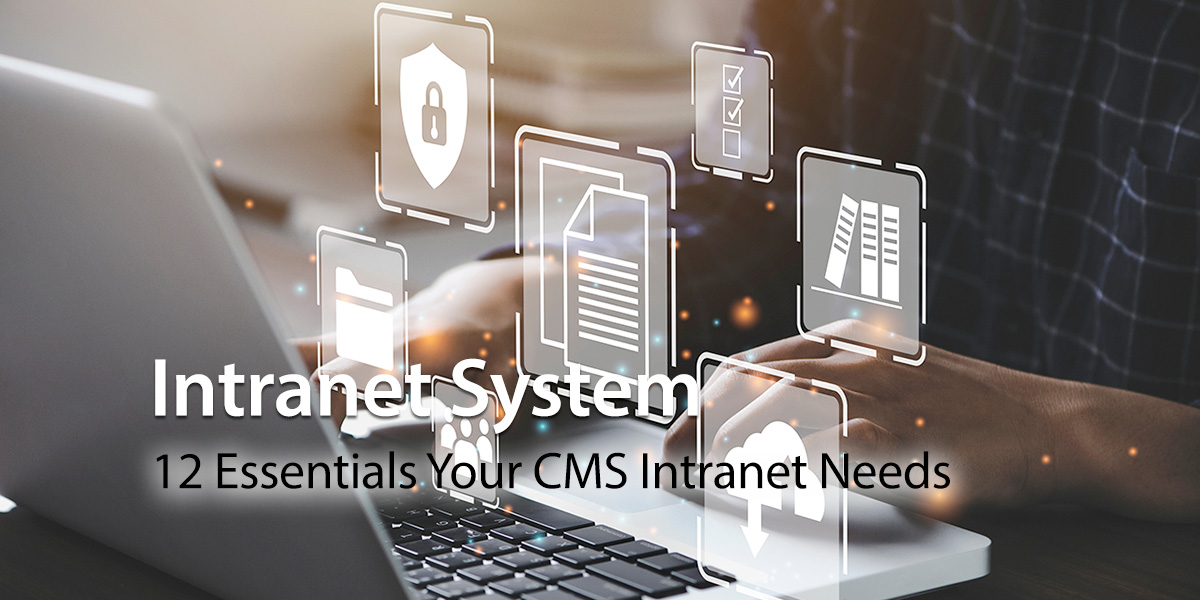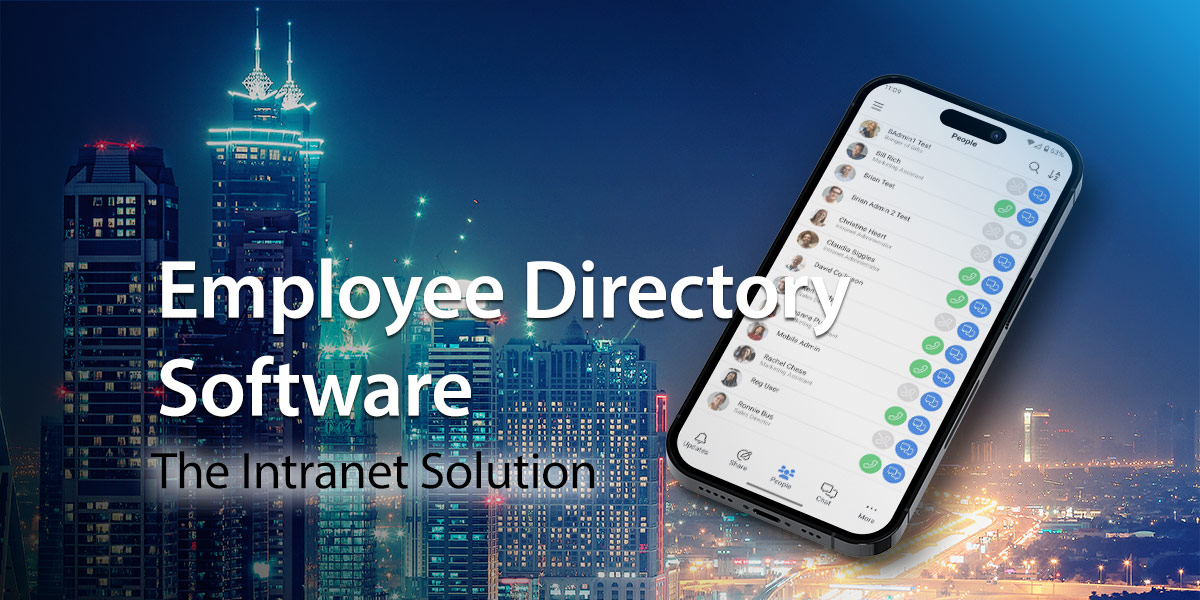Every business owner knows that a productive and engaged workforce depends on internal communication, collaboration, and information sharing. However, these can be hard to achieve if you manage teams of deskless and frontline workers or remote employees. The good news is that there’s a solution. Intranet applications simplify employee collaboration, communication, and file sharing. What’s more, they connect the entire workforce. With access to the tools employees need anytime and anywhere, everything is in one central location. Modern intranets empower employees wherever they are located and are critical to your company’s success.
Today’s post is essential reading for anyone new to intranet platforms. It’s also relevant for those looking to ensure they get the most out of their current corporate intranet. After all, modern versions have come a long way from the traditional intranets you may be familiar with.
So, make yourself comfortable as we dive into 25 essential intranet applications for today’s digital workplace.
Why Is A Company Intranet Important?
An intranet is a private network hosted by an on-premise web server or a cloud service. And it’s accessible to employees only.
Before we get started on intranet uses and applications, here’s a recap of the benefits of company intranets:
- Easier internal communications
- Streamlined collaboration
- Automated workflows, approvals, and business processes
- Better management of company know-how
- Improved information sharing
- Enhanced employee engagement
The modern intranet means all these fantastic benefits are available under one virtual roof. And that’s why intranet software is at the heart of the digital workplace.
25 Essential Intranet Software Uses & Applications
Let’s get down to business with our top 25 list of intranet applications. These applications reflect the latest intranet best practices. Incorporate them into your intranet strategy to ensure you maximize the platform’s potential.
1. Team And Company News Feeds
According to research from the Harvard Business Review, 47 percent of employees say company communications are irrelevant to their daily work. Intranet solutions can help you eliminate all the background noise with targeted, personalized team and company news feeds. Push notifications ensure key messages cut through communication barriers so no one misses out. Share what’s critical and keep employees in the know with a single source of truth.
Real-world example: An acquisition or merger is big news for all employees. Issue an announcement on the intranet news feed and simultaneously reach all employees, including on-the-go and remote workers. And unlike email, you can highlight the message with a push alert and track who’s read it with company intranet analytics.
2. Project Management
The company intranet is an all-in-one project management solution. From information sharing, task management, and communication, everything project teams need is in one location.
Real-world example: A project team is charged with improving the customer experience. Representatives are drawn from across the organization and include remote workers. A project space provides a secure platform for sharing insights and company information. Project team communication takes place on team chat. Automated workflows and processes are created within the intranet to monitor the progress of deliverables. And single sign-on access to Google Workspace supports real-time document editing.
3. Employee Recognition
Recognizing and appreciating workers’ efforts boosts morale and motivation and powers up employee engagement. Furthermore, it can reinforce the positive behaviors you want in all your people.
Real-world example: A public pat on the back from the boss in a company employee recognition program is always welcome. However, don’t underestimate the value of peer-to-peer recognition. Encourage employees to use team chat and give a shout-out to their colleagues. Then, sit back and watch your employee engagement rates skyrocket.
4. Instant Messaging And Team Chat
Faster and more responsive than email, instant messaging is now a mainstay in businesses worldwide. It’s a fantastic vehicle for resolving simple queries fast. Employees can send private messages or use team or themed #channels to engage in the conversation. Team chat works just like the chap apps your people use daily, making it a hit with office-based and remote workers alike.
Real-world example: A customer service rep has a product query they don’t know the answer to. Following a quick instant message to the team, the rep can respond immediately, resulting in a happy and satisfied customer.
5. Communication Tools
Instant messaging is only one of the internal communications tools your modern intranet offers. You can also use interactive blogs, digital staff newsletters, podcasts, and vlogs as two-way communication tools in your private intranet.
Real-world example: A weekly CEO blog helps the chief officer get up close and personal with employees. A mix of work-related and informal topics increases the CEO’s visibility and helps build personal connections. Workers can ask questions and offer feedback, opening up a direct communication channel.
6. Social Intranet Features
As far as employees are concerned, one of the key advantages of intranet software is the social features. Employees just love to get social. And it’s a lifeline for remote workers missing the camaraderie of the office. Use your intranet to replicate the user-friendly social features we all know and love in a work environment. Activity walls, follows, emojis, and @mentions ensure employees have fun while still keeping the emphasis on work.
Real-world example: Create a water cooler conversation channel on team chat to connect remote employees. Loneliness and isolation are big issues for home workers. This is one of the ways responsible employers can reduce the risks.
7. Centralized Platform For Document And Content Storage
Create one source of truth for your company’s employees with a central platform. Workers can access relevant information from company policies, data, or news to external resources like Microsoft Office or Google Workspace.
Real-world example: A new hire needs to locate a product manual to share in a catch-up meeting with a client. Rather than searching through manual files or email inboxes, the employee knows the latest version is on the team’s intranet page.
8. Collaboration Tools
Collaboration gets harder when you have remote workers separated by time and distance. However, the integrated collaboration tools in your intranet site bridge the gap.
Single sign-on access to Microsoft 365 and Google Workspace supports real-time document collaboration. And secure project forums provide spaces to complete projects, including brainstorming, internal communications, and task management.
Real-world example: Redesigning the customer-facing website involves collaboration across several departments. Some participants are remote workers. The team uses team chat for communication and private networks for brainstorming, sharing information and editing documents in Microsoft 365.
9. Company Calendars
Shared calendars on the company intranet help you coordinate schedules and better manage time. Furthermore, workers have one reference point for upcoming company events, training programs, and crucial board meetings.
Real-world example: Project team members enter their milestones and deadlines on a group calendar. Everyone can see at a glance where things are in real-time. It also helps the team leader better manage individuals’ workloads and report to management on progress.
10. Event Management
An intranet solution has everything you need when it comes to successful event management. For company-wide town hall meetings, departmental webinars, or social get-togethers, the intranet does the job regardless of size or scale. Online registration forms, agenda planning, and organizing support services are seamless.
Real-world example: A business organizes a new product launch meeting. Intranet software issues digital invitations to the sales and customer services teams. The event is live-streamed so remote workers can attend.
11. Employee Directory
Online employee profiles connect employees and support collaboration. Employee directories in modern intranets go far beyond a job title and phone number. Instead, LinkedIn meets Facebook with activity walls, photos, and personal and professional biographies.
Real-world example: Employee directories help new employees better understand the organization and how things work. They can also reach out directly to internal subject matter experts.
12. Employee Feedback Surveys
Keep your finger on the pulse and give workers a voice with employee surveys. The intranet makes it easy to harvest feedback on a variety of issues with surveys and snap polls.
Real-time example: Create an annual employee opinion survey in the corporate intranet. Use the data to measure and monitor progress on employee engagement and benchmark your performance against the competition.
13. Employee Experience Platforms
Creating a positive and engaging employee experience is critical to recruitment and retention. Your intranet doubles as an employee experience platform by connecting, informing, and empowering workers.
Real-world example: Give employees the option to personalize their home intranet page with quick links to their favorite tools and team news feeds. Customizing the interface and content based on the worker’s location, role, interests, and preferences will elevate the employee experience.
14. Integration With Third-Party Apps
Nowadays, businesses use a wide range of enterprise apps, from CRM platforms and HR systems to Microsoft 365 and Google Workplace. Modern intranet platforms seamlessly integrate with these third-party apps, plus a whole lot more. Single sign-on boosts productivity and saves time and the hassle of switching between different apps.
Real-world example: Unleash the power of Google Workspace or Microsoft 365 by embedding these apps directly in your intranet pages. Employees can view, edit, and collaborate on documents in real-time, all from within the corporate intranet.
15. Automated Processes
Every business involves form filling, from offline data collection to vacation requests and ordering supplies. Automated online processes are faster and more accurate. And the company intranet automatically routes the form to the relevant department for action.
Real-world example: HR creates a standardized vacation request form using the intranet’s forms builder or an embedded Google or Microsoft Forms. The employee completes the form online and the request goes automatically to the manager for approval. The approved leave request is then forwarded to payroll and HR for action.
16. Streamlined Approvals
Automated approvals are just as crucial to efficient and effective business processes. Traditional paper or email processes can take time and effort. And they are often prone to error. Automated approvals save time and improve accuracy.
Real-world example: Out-of-town managers are often a bottleneck when it comes to approvals. However, with anytime, anywhere access, the manager attending a sales conference can still approve business processes while away from the workplace.
17. Centralized Knowledge Management
Knowledge management is more straightforward when you have just one user-friendly intranet platform. Use the intranet to capture internal know-how and organize it in a central repository, accessible 24/7/365.
Real-world example: Standard operating procedures are brought to life using podcasts and explainer videos to supplement the text. An advanced search makes it easy for workers to find what they need at just the right time.
18. Onboarding
The company intranet will help your new employees settle in smoothly and get up to speed quickly. Create a dedicated onboarding portal with all the information, training materials, and resources new starters need. Intranet-based onboarding also makes it easier for managers to monitor compliance and step in with timely support when needed.
Real-world example: Standardize onboarding with an intranet-based checklist. Ensure all new hires have the same, consistent experience. And it helps managers monitor and track progress more easily so recruits get off to the best start possible.
19. Professional Development
Training and development are good for business. It ensures employees’ skills and knowledge are current, and training also boosts engagement and motivation. However, traditional in-person professional development can be costly. You have to pay for the venue, the tutors, and staff cover. It can add up quickly.
That’s where online learning can make a difference. Intranet-based eLearning is more flexible, time-efficient, and cost-effective. Plus, you can deliver training in various forms, including podcasts, webinars, and how-to videos.
Real-life example: Mandatory training on safety and health takes place as a live-streamed webinar so remote employees can participate. Online reporting ensures managers can access the data needed for auditing and compliance.
20. Quizzes
Intranet-based quizzes are a versatile tool. You can use them for employee feedback or to test knowledge and understanding in training and development. And fun quizzes are a great way to develop a positive company culture.
Real-world example: Reinforce key learning from the mandatory safety and health seminar with a follow-up quiz. And use the data to inform future professional development in the topic.
21. Offboarding
Intranet platforms help you manage offboarding more effectively. The insights gained from departing workers reveal a lot about the organization’s well-being. Employee intranets simplify the process of exit interviews, knowledge transfer, and termination documents.
Real-world example: Develop a digital offboarding checklist to ensure you transfer knowledge effectively and reduce your risk exposure. A checklist also helps you dive deep into the employee’s reasons for leaving to inform your retention efforts.
22. Metrics
Modern intranets come with integrated analytics to help you track the platform’s effectiveness. Find out how staff use the software to support their daily work and ensure your intranet strategy’s goals and objectives are aligned.
Real-world example: Metrics on views and clicks help you determine the effectiveness of your communication channels. Find out which ones really resonate with staff and the best time to publish company-wide announcements.
23. Content Management System
The modern intranet comes with its own content management system. Intranet users can create, edit, and manage content without needing a PhD in computing. Engaging employees in this way powers up the employee experience and boosts company culture.
Real-world examples: Team members can create a wiki on the intranet to answer employees’ FAQs. It could be department-based with responses to common queries for sales staff or service technicians. Or it could be company-wide with, for example, FAQs on employee benefits and wellness initiatives.
24. Mobile Intranet App
Not all your people have access to a desktop computer all the time. In fact, up to 80 percent of global workers are deskless. A dedicated mobile app rather than mobile-friendly software means employees enjoy all the same features as desktop users.
Real-world example: Service technicians on the road can use the mobile app to access detailed product manuals instantly. And they can ping a direct message to a colleague for expert help and advice if needed.
25. Advanced Search
All these fantastic applications are only helpful if employees can quickly locate what they need. An intelligent search tool makes it easy to find company information within the intranet platform when it matters.
Real-world example: Improve information discovery with advanced search features like tagging, results filtering, and quick previews.
Intranet Software FAQs
What are the advantages of an intranet?
An intranet is a private network that helps employees share information and collaborate. Here are the headline advantages:
- Easy access to information and resources boosts employee productivity and engagement.
- Internal communications are enhanced with news feeds, instant messaging, interactive blogs, notifications, and alerts.
- Collaboration is streamlined with document management and file-sharing tools, employee profiles, project spaces, and digital task management.
What are the disadvantages of intranet platforms?
Intranets can be costly and time-consuming to set up, especially if you go down the DIY route rather than an out-of-the-box solution. Furthermore, some options line Microsoft SharePoint often require additional plug-ins that can add to the costs.
Moreover, traditional intranets have often been dismissed as dusty document libraries. However, modern versions are dynamic, versatile platforms encompassing much more than just document management.
As with any digital platform, without robust security measures, intranets can be vulnerable to hacking and data breaches.
What’s the difference between an intranet and an extranet?
A company intranet is a private network that’s only accessible to employees. By contrast, an extranet extends access to authorized third parties like vendors, clients, and partners.
Ready to take the next step on your intranet journey? Get in touch with the expert MyHub team today. Book a demo or 14-day free trial and explore the wealth of applications and uses the intranet delivers.













